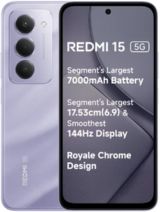Redmi 15 alternatives
Tap above to see alternatives.
vivo V60e alternatives
Tap above to see alternatives.
2x2.3 GHz Cortex-A78
6x2.0 GHz Cortex-A55
4x2.5 GHz Cortex-A78
4x2.0 GHz Cortex-A55
8GB 128GB (UFS 2.2)
8GB 256GB (UFS 2.2)
8GB 256GB (UFS 2.2)
12GB 256GB (UFS 2.2)
f/1.75, (wide), 1/2.88" 0.61μm, PDAF
Auxiliary lens
f/1.88, 23mm (wide), 1/1.56", Samsung HP5, PDAF, OIS, Up to 30x Optical Zoom
8 MP
f/2.2, 120˚ (ultrawide)
1080p
f/2.2, (wide)
f/2.0, 22mm (wide), 1/2.76", 0.64µm, AF
1080p
7 5G bands
n1, n3, n5, n8, n28, n40, n78
10 5G bands
n1, n3, n5, n8, n28, n38, n40, n41, n77, n78
In this performance comparison, the vivo V60e with its MediaTek Dimensity 7360 chipset scores higher on AnTuTu, offering better overall performance than the Redmi 15.
vivo V60e offers 3 years of OS updates, whereas Redmi 15 provides 2 years. For security updates, vivo V60e offers 5 years of support compared to Redmi 15's 4 years.
vivo V60e features a superior AMOLED display, while Redmi 15 comes with an LCD panel. In terms of smoothness, Redmi 15 offers a higher 144 Hz refresh rate, ensuring fluid scrolling and animations. vivo V60e also boasts a brighter screen with 5000 nits of peak brightness, enhancing outdoor visibility. Both phones have the same screen resolution.
Redmi 15 comes with a larger 7000 mAh battery, which may offer longer usage on a single charge. vivo V60e also supports faster wired charging at 90W, compared to 33W on Redmi 15. Redmi 15 supports wireless charging at -2W, while vivo V60e does not support wireless charging.
vivo V60e offers better protection against water and dust with an IP69 rating.
- Redmi 15 – Check price here
- vivo V60e – Check price here
¹ Scores can vary even with the same chipset due to RAM, thermals, and software optimization.












